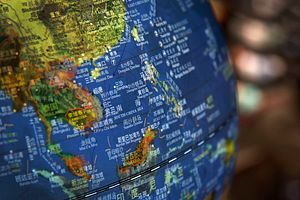China and Vietnam are engaged in a high stakes standoff on the high seas. Since early July, a Chinese ship has intermittently surveyed oil and gas blocks located within Vietnam’s continental shelf. Chinese Coast Guard vessels have maneuvered dangerously around Vietnamese vessels responding to these Chinese incursions. Last week China upped the ante by resuming seismic survey operations and also moving a ship it uses to install oil rigs into Vietnam’s claimed economic exclusion zone, just 56 miles off the coast of central Vietnam. China is using these bullying tactics to dissuade Hanoi from continuing with its drilling operations near the disputed Vanguard Bank.
We have seen this movie before. In 2014, China deployed an oil rig into Vietnam’s claimed economic exclusion zone. Back then, the conflict resulted in a dramatic increase in Vietnamese defense cooperation with the United States. The same is likely to be the case now. Sino-Vietnam relations highlight what happens when Chinese coercion goes too far, and is an example of how the United States can capitalize these opportunities to build closer relationships with China’s neighbors.
The 2014 deployment of a Chinese oil rig to contested Vietnamese waters was the most significant downturn in Sino-Vietnamese relations since the Chinese Navy killed 64 Vietnamese sailors at the disputed Johnson Reef in the Spratly Islands in 1988. The 2014 standoff began when China deployed the China National Offshore Oil Corporation (CNOOC) Hai Yang Shi You 981 oil platform for exploratory drilling approximately 120 nautical miles east of Vietnam’s Ly Son Island. The deployment of the rig suggested China was making an extraterritorial claim to hydrocarbon resources on the westward side of the median line between China and Vietnam. Tensions rapidly escalated and at the apex of the standoff, as many as 130 Chinese boats and ships maneuvered in the vicinity of approximately 60 Vietnamese vessels resulting in numerous collisions attributed to Chinese aggression. Ultimately, the standoff ended when China withdrew its rig from the area, one month ahead of schedule.
Chinese coercive tactics to settle South China Sea disputes were a catalyst that prompted Hanoi to seek enhanced security cooperation with Washington. Just five months after the 2014 standoff, the United States partially relaxed its ban on lethal weapons sales to Vietnam, enabling Vietnam to purchase nonlethal maritime defense equipment. While diplomatic work lifting these restrictions likely began before the crisis, Chinese coercion at sea may have energized Hanoi to make a renewed push for Washington to relax its ban. In June 2015, then Secretary of Defense Ash Carter committed to providing Vietnam $18 million for the acquisition of Coast Guard patrol vessels and signed a Joint Vision Statement on defense relations with his counterpart. During President Barack Obama’s visit to Hanoi the next year, the United States fully rescinded the elements of prohibition on selling lethal weapons which had not been lifted two years earlier.
As the United States Navy Attaché in Vietnam in the years following the incident, I witnessed how these foundational strategic agreements enabled Vietnam’s Navy and Coast Guard to begin unprecedented collaboration with their U.S. counterparts. One year after the 2014 crisis, naval ships from Vietnam and United States increased complexity of joint training maneuvers at sea as a part of the annual goodwill ship visit to Vietnam. Then in August 2016, Vietnam’s Navy hospital ship and personnel participated for the first time in the annual Pacific Partnership humanitarian assistance disaster relief exercise. The periodicity of United States Navy ship visits increased starting in 2016 and in May 2017, the United States made its first transfer of a Coast Guard Cutter to Vietnam. This was followed by the historic first United States post-war aircraft carrier visit and by Vietnamese naval personnel participation in the Rim of the Pacific (RIMPAC) exercise in 2018.
If Hanoi follows the same template as it did following the 2014 standoff, we should expect Vietnam to seek closer defense links with the United States following the current standoff near Vanguard Bank. Vietnam’s president will likely visit the United States this fall, which will provide its Ministry of National Defense the strategic latitude to advance overall defense ties. New strategic defense cooperation agreements, support a second United States aircraft carrier visit, or its commitment to send a ship to participate in next year’s RIMPAC exercise are some ways Vietnam could indicate its intent to advance the defense relationship with the United States.
United States Democratic and Republican administrations from Clinton to Trump have recognized the benefits of forging closer ties with Vietnam. Defense relations, however, has traditionally lagged behind the rest of the overall bilateral relationship. China’s use of coercive tactics in the current standoff near Vanguard Bank creates an opportunity for Vietnam to advance security ties with the United States. However, Hanoi will want to ensure enhanced defense cooperation is sustainable. This may require Washington to calibrate its engagement pace or to respond flexibly to Vietnamese ideas on how to best advance defense relations.
Captain Christopher Sharman, U.S. Navy, is a Federal Executive Fellow at the Stanford University Hoover Institute. He previously served as a Navy Attaché in both Hanoi and Beijing and has been assigned to several forward deployed ships based in Japan. The views expressed herein are those of the author and do not reflect the official policy or position of the U.S. Navy, U.S. Department of Defense, or the U.S. Government.

































